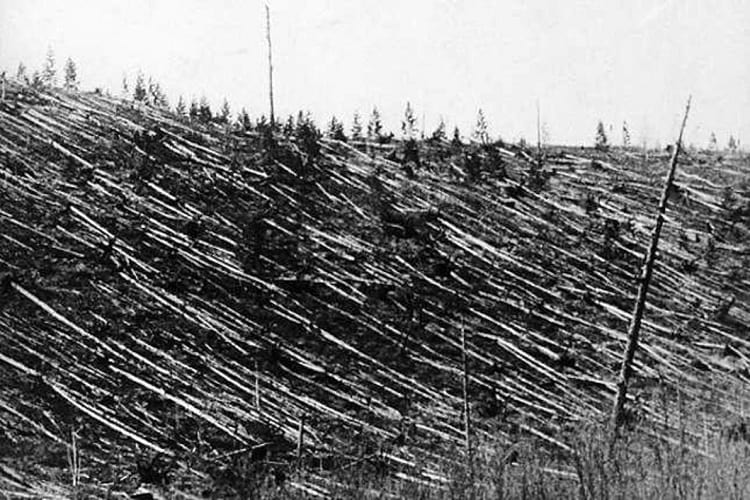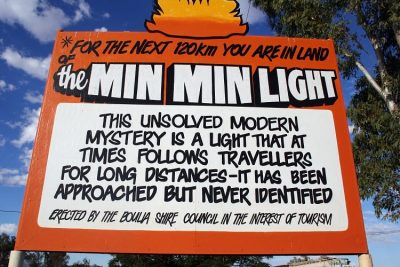Tunguska Event and the Vulnerability of Our Universe
Share

Fallen trees, aftermath of the Tunguska event.
We live in a Galaxy replete with millions of stars, the sun being just one of them. And billions of such Galaxies constitute Universe or Cosmos. Some galaxies are so far away from earth that light must travel for billions of years to cover this distance. Hence we never know their ‘present’ status. All we know is how they appeared billion-years-back when the earth was a ball of fire with no life existing on it.
Now imagine a huge cosmic body from the universe hitting a part of the earth and exploding. The blast happened at 7.15 AM on June 30, 1908, and is known as Tunguska Event.
What was the Tunguska Event?
Location was Podokamennaya Tunguska River, Siberia, Russia. No wonder, even 110 years later, our knowledge about ‘why’ and ‘how’ of the blast is inconclusive. All we know is that this explosion was a thousand times more devastating than the atomic bomb that was dropped on Hiroshima, Japan, in 1945. Yet, surprisingly, no human casualty was officially reported (at the Tunguska Event). International Newspapers reported the event as volcanic eruption based on similarities with 1883 volcanic eruption of Krakatoa.
Russian Revolution happened in 1905 and repeated in 1917. The year 1914 saw World War-1. Partly because of these volatile times and partly because of the extremely inhospitable climate of the Tunguska region, a dedicated investigation of Tunguska Event couldn’t be carried out for well over a decade.
What caused the Tunguska Event?
Various theories have done rounds to explain the event. The absence of an impact crater, no evidence of extra-terrestrial material (later investigations though claimed to have found them) and eyewitness accounts varying widely lead to the conclusion that Tunguska Event was caused by a comet hitting the earth.
The comet, largely made of ice, vaporized completely before the hit. But doubts were raised on how an ice body can penetrate so deep into earth’s atmosphere. A nuclear explosion by some alien species was too farfetched to hold ground.
Black hole colliding with earth, causing matter-antimatter reaction leaving no debris, was also mooted. The anger of Gods and alien spaceship crashing while searching for water were other outlandish views.
Lucas Gasperini from the University of Bologna argued that a small lake, Cheko was created by the Tunguska explosion. The lake is unusually deep, he said, whereas all surrounding water bodies are shallow. Also, the lake finds no mention in official records prior to 1908, he contended. Wolfgang Kundt, an Astrophysicist, said the explosion was caused by 10 million tons of natural gas released from earth crust.
None of the above theories succeeded in quelling all doubts. The only thing known for sure was that what fell on earth was a cosmic body. Another theory of a large meteoroid of 50 to 100 meters diameter colliding with the earth seems most plausible. Such meteoroid collisions happen once in a few hundred years.
Russian team led by Leonid Kulik made a trip to the explosion site in 1927 and found eighty million burnt and splintered trees lying scattered across 820 square miles area. A 50Km spread of singed vegetation lay in the butterfly shape. The ground was so deeply scorched that little vegetation grew there even as two decades passed. The manner in which the mutilated trees were sprawled around the epicentre of blast supports the asteroid theory. The energy of the explosion is estimated to have been 10-15 megatons of TNT (trinitrotoluene) and the asteroid exploded some 3-6 miles above ground.
Regarding why no extra-terrestrial material was found at ground zero, it was argued that swampy earth may have swallowed it deep down. Subsequently impact related minerals, like Nano-diamonds, metallic and silicate spherules were found and these were linked to the crashing meteoroid body.
Eyewitnesses saw blasts from as far as 800 Kilometres, strong hot winds shook buildings and shoved materials, seismic waves were recorded in the Western Europe; these point to a cosmic body crash. Impact crater did not form because the meteoroid vaporised completely in the air itself (friction in earth’s atmosphere causes this vaporisation producing bright light which flashed across Siberian and European skies at night).
The caveat in asteroid theory is that the impact related minerals found at the site may have been cosmic dust from small meteorites which keep disintegrating in earth’s atmosphere every day. Further, it is inconsistent with some eyewitnesses saying that explosions lasted more than 10 minutes. A meteoroid fall couldn’t have generated multiple explosions for 10 minutes.
Tunguska event is more than a scientific curiosity. It shows our extreme vulnerability to cosmic events which happen every 100 to 1000 years. Scientists estimate that if the fall of Tunguska cosmic body was delayed by just 4 hours, its target would have been St. Petersburg, the capital of Imperial Russia and not the sparsely inhabited marshy range of Siberia. Should such event happen in today’s world, the extent of damage can only be imagined. Our interface with the Universe is as mysterious as the Universe itself.
Enjoyed this article? Also, check out “The Hum: The Mystery Behind a Humming Noise that Can Be Heard Worldwide“.
Fact Analysis:
STSTW Media strives to deliver accurate information through careful research. However, things can go wrong. If you find the above article inaccurate or biased, please let us know at [email protected]













